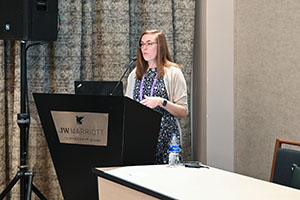
Presented by Katie Brown, University Registrar, Aspen University
Live from AACRAO-SEM
Katies’s session examined how the Registrar’s Office at Aspen University utilized an annual departmental audit to advance continuous improvement initiatives.
Topics addressed included:
How Aspen created department audit standard
Formation of audit schedule
Continuous improvement initiatives
How to fit initiatives into the goals of the university
Continuous improvement is a popular topic across various industries and is increasingly being implemented in higher education. Unfortunately, there isn’t a single continuous improvement plan that works for every institution, and it is important to ensure that any plans or initiatives are adapted to fit the unique needs and goals of individual institutions.
There are many considerations to account for when getting started on your continuous improvement plan; some of these include:
Why are you taking on this project
What resources available
What is your timeline
How can you achieve stakeholder buy-in
How will you measure success
The answers to these questions will be unique to your situation and help you formulate your continuous improvement plan as you proceed.
Getting Started
Creating a baseline for the department is important for evaluating your current situation, establishing expectations, and determining definitions of success. It’s also important to set standards that you want your department to meet, such as:
AACRAO, Accreditors, Regulators
Personal Standards - Customer service, accessibility, etc
Developing a mission statement for the department is an important task for aligning goals amongst team members.
There are a variety of pathways higher ed professionals can take to develop their departmental audit; this can include both free and paid resources (such as the AACRAO Self-Assessment). However, your department audit needs to be scaled to fit your needs and available resources at the end of the day.
Timeline
Be realistic when developing a timeline for your audit and ensure it aligns with your department’s schedule and busier periods. Additionally, create a plan for regular implementation and ask whether this is a one-time audit or repeated on a schedule. Finally, creating a chart to stay on top of all the projects and tasks needed to complete your departmental audit never hurts.
As part of this process, it is also important to include invested stakeholders in the process; some of these may include:
As part of the Aspen process, each stakeholder group looks at particular processes relevant to their position. When asking “why something is done this way,” the answer “we’ve always done it this way” is not an acceptable answer.
Measuring Success
Initially, for Aspen, simply creating the audit was their measure of success. However, as time went on, ensuring success has grown to include specific and measurable actions and implementing a 3rd party evaluation process.
Results
Increased efficiency
Generating ideas for the future
Holistic view of the university
Good resource for budgeting and proposals
The department audit has been beneficial for Aspen University in maintaining objectivity and effecting change. The department audit has also been constructive for budgeting and staffing requests by giving concrete data behind making those requests. 
Katie closed the session with an open discussion and Q&A from the audience; several members had questions and examples from their own experience creating and implementing a departmental audit. Some of the questions asked included:
Q - Do you conduct this audit every year?
A - Yes, we do; it usually takes us about six months to go through everything.
Q - What kind of feedback do you take, students?
A - No students so far, generally staff - none of the feedback has been negative, but often surprising and sometimes simple to change
Q - Is there a particular measure you use to decide what needs to be changed?
A - Complaints are often a good way to know about things that need improvement; if it has gotten to the registrar, it’s definitely time to fix it. It's also helpful to be encouraging people to be a part of the solution. You may find people on your team who want to point out issues, but not be a part of the solution.
Q - Do you have advice for things that the audit reveals that should be changed but you cannot for various reasons.
A - If it’s little things, fix them immediately; even if you only change 5 of the 20 suggestions, it gives them a sense of ownership
Interested in developing your own department audit? Visit AACRAO's On-Demand Learning page to gain learn more about the Registar's Self-Assesment.